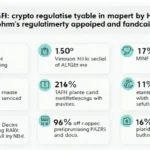Introduction
As global financial systems evolve, the concepts of Central Bank Digital Currencies (CBDCs) and stablecoins have taken the forefront of discussions in the cryptocurrency space. With $4.1 billion lost to DeFi hacks in 2024, it’s crucial to explore how emerging technologies might shift the tide towards more secure financial frameworks. Vietnam’s initiative to explore its own CBDC and its growing interest in stablecoins provide a rich context for analyzing potential impacts on both consumers and the financial landscape at large.
This article delves into the significance of Vietnam’s CBDC alongside stablecoins, presenting valuable insights and practical implications for users, investors, and policymakers.
Understanding CBDCs and Stablecoins
What are CBDCs?
CBDCs are digital forms of fiat currency issued by a country’s central bank. Unlike conventional cryptocurrencies that operate on decentralized networks, CBDCs maintain centralization as they are directly regulated by government authorities. They aim to combine the best aspects of traditional currency and digital payment systems.

Stablecoins Explained
Stablecoins are a type of cryptocurrency designed to maintain a stable value relative to a specific asset or basket of assets. This stability makes them appealing for transactions, especially in volatile crypto markets. Stablecoins can be backed by fiat currencies, commodities, or even algorithmically controlled.
Vietnam’s Current Financial Landscape
Vietnam has seen a notable growth in its digital economy, with the digital user growth rate reaching 8% in 2023. This rise highlights a growing appetite for innovative financial solutions among Vietnamese consumers. The government has identified the need to adapt to these changes, exploring CBDC as a potential tool for enhancing financial inclusion.
The Impacts of CBDCs in Vietnam
Implementing a CBDC in Vietnam could revolutionize the country’s financial ecosystem. Here’s how:
- Increased Financial Inclusion: CBDCs can provide unbanked populations with access to digital financial services.
- Reduced Transaction Costs: Digital transactions can be cheaper and faster than traditional banking methods.
- Enhanced Traceability: A state-controlled CBDC offers greater tracking of transactions, potentially reducing illicit activities.
Stablecoins: A Practical Solution for Transactions
Stablecoins present unique opportunities in Vietnam’s economy. Here’s why:
- Price Stability: They help mitigate the volatile nature of cryptocurrencies, making them suitable for day-to-day transactions.
- Cross-border Payments: Stablecoins facilitate faster and cheaper international remittances, a significant advantage for a country with a large expatriate community.
- Investment Potential: Increasing interest from investors in stablecoins can lead to liquidity enhancements in local markets.
Challenges Ahead
Despite promising prospects, Vietnam faces challenges in adopting CBDCs and stablecoins effectively:
- Regulatory Concerns: Developing suitable regulations is paramount to ensure both consumer protection and adherence to anti-money laundering laws.
- Technology Infrastructure: The need for robust tech infrastructure to support CBDC systems is critical.
- Public Trust: Building trust in a state-issued digital currency amidst skepticism towards traditional banking systems is essential.
The Future of Vietnam’s Blockchain Adoption
The evolution towards a CBDC or the mainstream acceptance of stablecoins will depend on several factors, including: Consumer education, regulatory frameworks, and technological readiness.
Insights suggest that if handled correctly, Vietnam could become a leader in blockchain adoption in the ASEAN region.
Conclusion
Vietnam’s journey towards embracing CBDCs and stablecoins may signify a transformative phase for its financial ecosystem. As traditional and digital finance converge, stakeholders must collaborate to address challenges such as regulatory hurdles and technology infrastructure. In doing so, Vietnam can secure a position as an innovative financial hub, leading the charge toward a secure and inclusive digital economy.
In conclusion, staying informed about the developments in Vietnam CBDC and stablecoins is crucial for investors and consumers alike. As new technologies emerge, the right adaptations could pave the way for an engaging and secure financial future.




